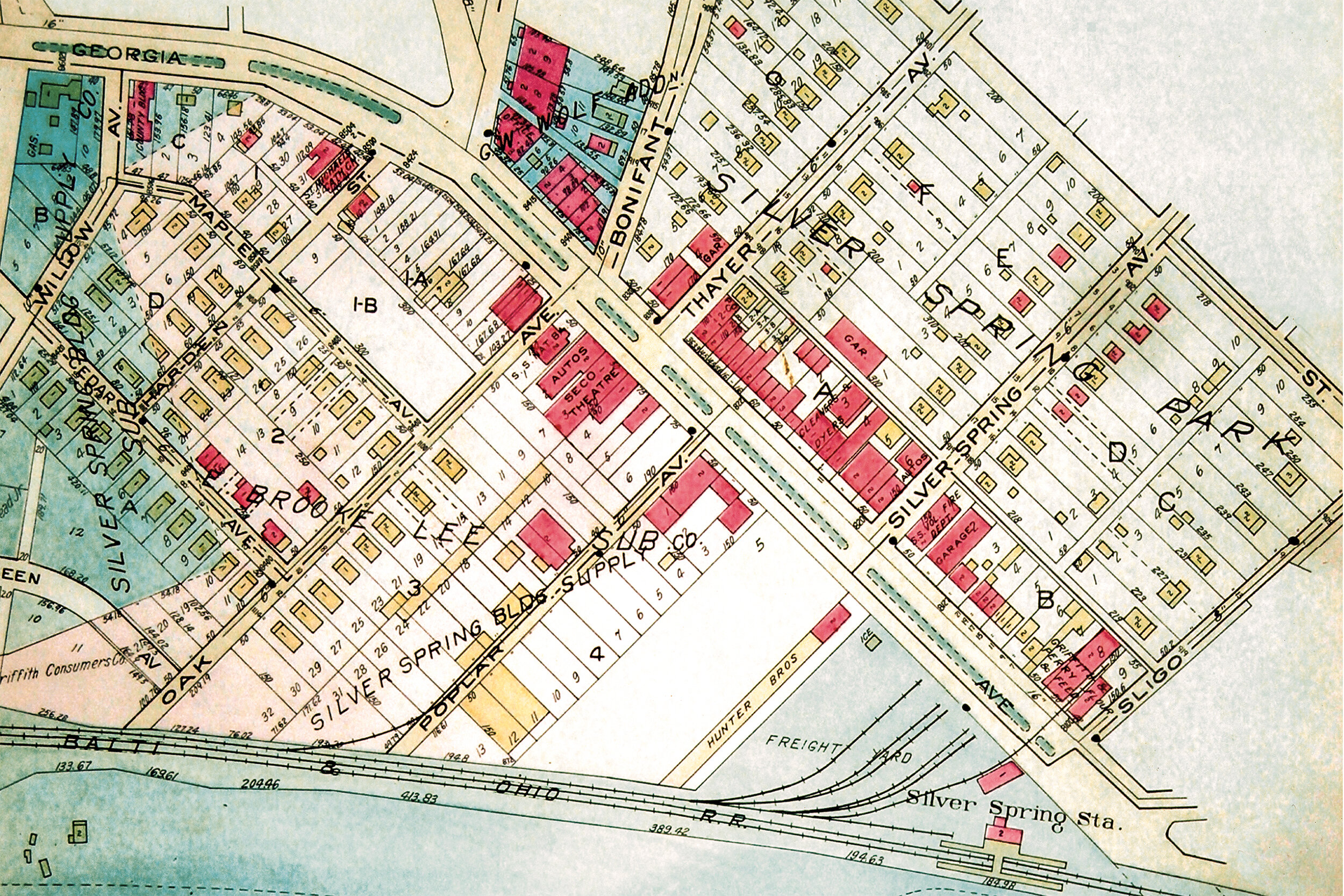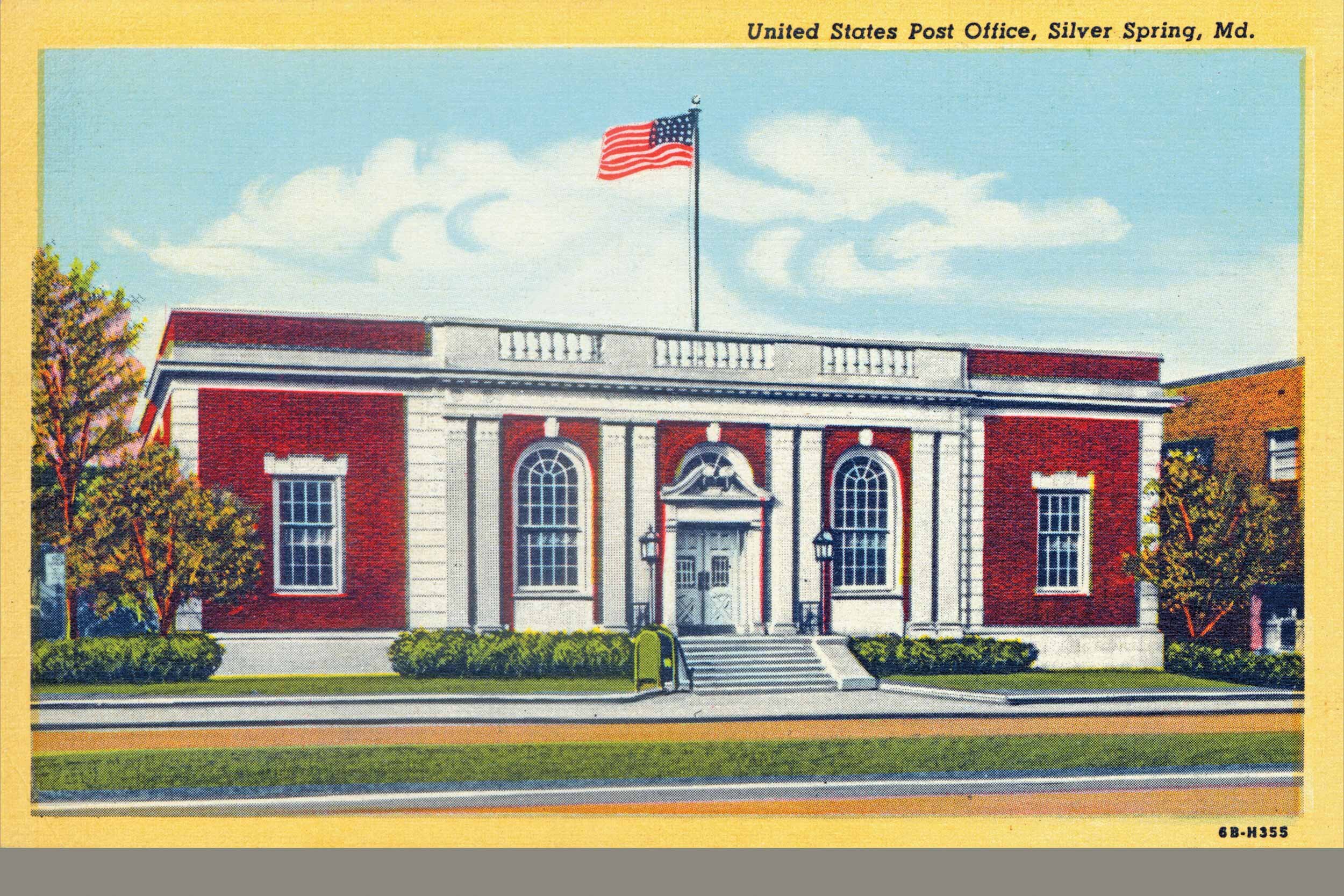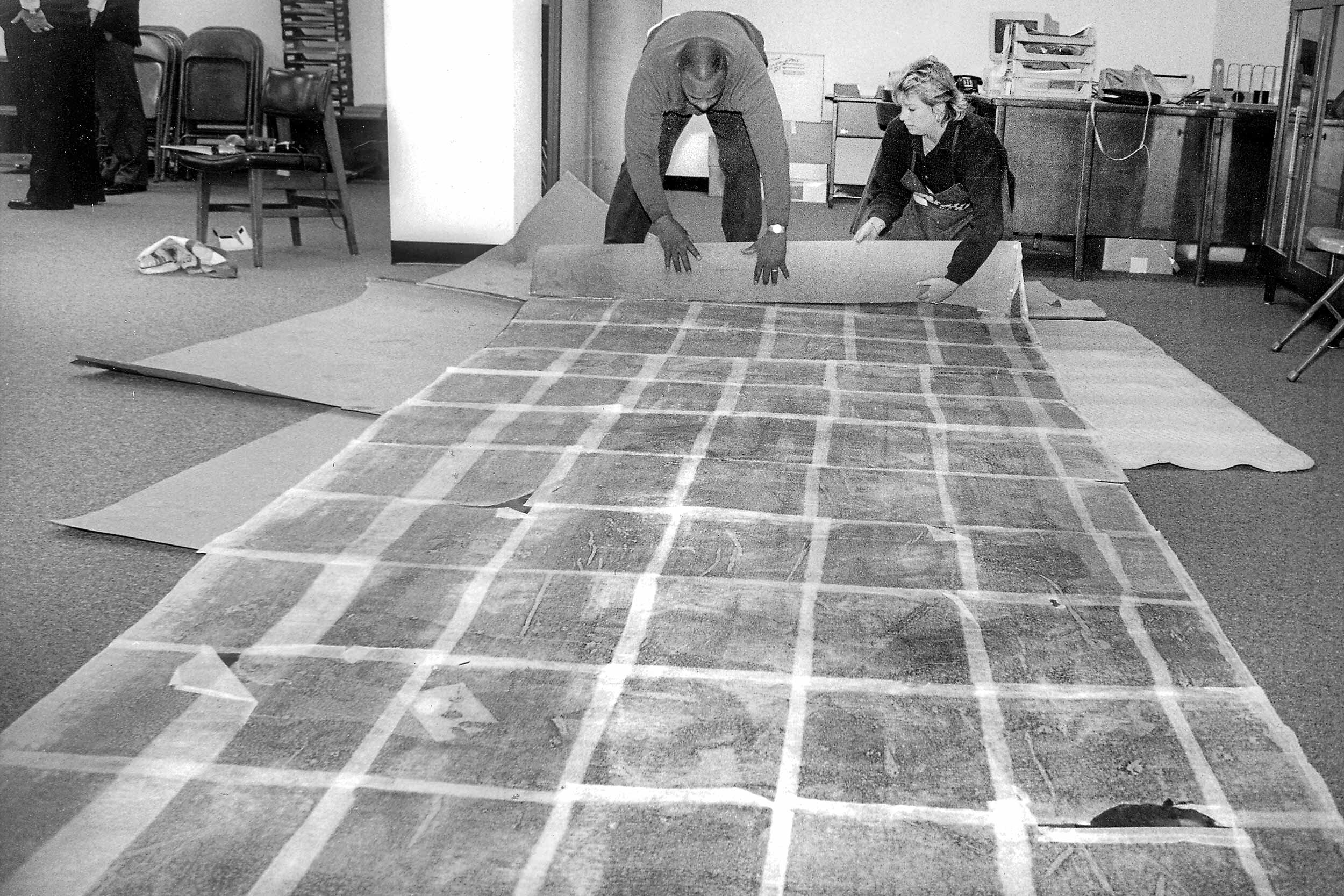
PLATTING A COURSE
A portion of Plate 30 from Atlas of Montgomery County, Volume One, published 1931. Red depicts buildings built of brick. Note the area between Georgia Avenue & Fenton Street, today known as Fenton Village, consisted mostly of single family homes, and was called Silver Spring Park. This neighborhood name also applied to the area east of Fenton; today it is part of the more extensive area named East Silver Spring. Collection of Silver Spring Historical Society.

WWII Patriotism
Today you can buy caramels here. In 1943, this was a bank promoting “Back the Attack,” a WWII victory exhibit sponsored by The Washington Post and held on the grounds of the Washington Monument. The sign in the window of Frank L. Hewitt’s Citizens Building & Loan Association features a quote by General Dwight D. Eisenhower that reads “We are playing in the big leagues. You can’t hit a home run by bunting. You have to step up there and take your cut at the ball.” The analogy referred to the all-out Allied invasion of Italy on September 3, 1943, rather than individual attacks on “stepping stones” such as Sardinia, Corsica, or Crete. Photo by Nellie Hewitt Stinchcomb.

What came before
The site of the 1937 Silver Spring post office, 8412 Georgia Avenue, was previously occupied by a single family home known as The Elms (this photo is ca. 1910). Built approximately 1897, the wood frame house was occupied by Gist Blair, who served as Silver Spring’s first postmaster from 1899 to 1906. It was later the home of Silver Spring’s second postmaster, Frank L. Hewitt, and his family during the 1920s. Courtesy Silver Spring Historical Society and John P. Hewitt.

Early Civic Leader
“A place by the side of the road” is how Frank L. Hewitt (1877-1944) described Silver Spring when he arrived in 1903, establishing Hewitt Real Estate & Insurance. He also served as Silver Spring’s second postmaster (1906-14) and founded Citizens Building & Loan Association (1928) in addition to being active in the Maryland National Guard, Silver Spring Lion’s Club, and Silver Spring Chamber of Commerce. Ca. 1920s photo courtesy Nellie Hewitt Stinchcomb.

Post Card Perfect
A civic landmark, the Silver Spring post office was featured on a “linen”-textured postcard published 1946 by Curteich–Chicago. Collection of Jerry A. McCoy.

Greetings from home
The postcard’s message was written by Harold W. Thatcher, who lived in Silver Spring on Greenbrier Drive, and mailed to his son Sanford who was away at camp. Collection of Jerry A. McCoy.

Century Marks
A souvenir envelope features the 100th anniversary postmark commemorating the 1899 establishment of Silver Spring’s post office. Cachet and postmark were designed by Jerry A. McCoy. The 15¢ airmail stamp was first issued in Silver Spring May 3, 1963. Featuring Montgomery Blair, who served as President Abraham Lincoln’s postmaster general, the stamp commemorates the International Postal Conference centennial. Initiated by Blair, son of Silver Spring’s founder Francis Preston Blair, the I.P.C. established uniform mail rates and weights between nations. Collection of Jerry A. McCoy.

In the beginning
A village named Sligo, established in the 1830s by Chesapeake & Ohio Canal workers from County Sligo, Ireland, was located at the crossroads of the current Georgia Avenue and Colesville Road. This is a preliminary sketch for a 1937 mural, “The Old Tavern,” by artist and Russian immigrant Nicolai Cikovsky, commissioned for the post office . Courtesy of Silver Spring Historical Society.

Total Recall
Artist and Russian immigrant Nicolai Cikovsky interviewed 79-year-old Blair Lee, former U.S. Senator (D-Md.) and born here in 1857, for this mural called “The Old Tavern.” Lee had many memories of what the community, then called Sligo, looked like. The main crossroads of Sligo were Washington & Brookeville Turnpike (Georgia Avenue) and Ashton, Colesville & Sligo Turnpike (Colesville Road). The Eagle Inn, on the right side of the mural, stood on the southwest corner of the intersection. Photo by Chip Py.

Final Preparations
Workers apply finishing touches to the mural “The Old Tavern” in December 1937. Post office murals were traditionally installed above the postmasters’ office doors. Collection of the National Archives.

Handled With Care
Removed from the Silver Spring post office in 1981, the mural was located by Silver Spring Historical Society founder Jerry A. McCoy in 1994. When postal employees unrolled the mural for the first time, it was covered with Japanese tissue paper to protect the painting’s surface. Friends of the Silver Spring Library raised $25,000 to conserve the mural, rededicated at the Silver Spring Library on Colesville Road, July 7, 1997. As of August 2018, its new location is by the post office on the ground floor of the library building at Fenton St. and Wayne Ave. Photo by Jerry A. McCoy.

Ever-Evolving Corner
In 1932 a private residence at 8424 Georgia Avenue was converted to use as a funeral home. In 1938 the home was removed for construction of a new funeral home, illustrated in this 1940 Chesapeake and Potomac Telephone Company of Baltimore City directory. This structure was razed in the early 1980s for construction of 8484 Georgia Avenue. Collection of the Maryland Department, Enoch Pratt Free Library, Baltimore.












